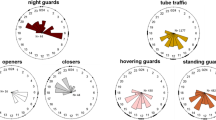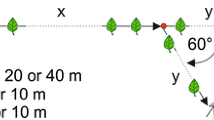Abstract
Social insects need to defend their nest against robbery, parasitism and predation. The stingless bee Tetragonisca angustula is unique in that it has guards that hover near the nest entrance in addition to guards that stand at the entrance. We tested both the general hypothesis that hovering guards increase the effectiveness with which flying intruders are detected and the specific hypothesis that hovering guards improve the detection of workers of the obligate robber bee, Lestrimellita limao. In an intraspecific study comparing colonies, we found a strong positive relationship between the number of hovering guards and the distance at which a dummy robber bee or L. limao worker, experimentally moved towards the nest entrance, was detected. These results were mirrored in an interspecific study showing that four species of stingless bees with similar population colonies but which lacked hovering guards, detected L. limao only at the nest entrance, in contrast to T. angustula. In addition, we found that a greater number of attacks by guards occurred when dummies were impregnated with citral, a major component of L. limao mandibular gland odour. Our results support the hypothesis that T. angustula hovering guards increase the detection perimeter for flying intruders, especially L. limao.



Similar content being viewed by others
References
Armstrong EA (1949) Diversionary display. Ibis 91:179–188
Bego LR, Zucchi R, Mateus S (1991) Notas sobre a estratégia alimentar: Cleptobiose de Lestrimelitta limao Smith (Hymenoptera Apidae Meliponinae). Naturalia 16:119–127
Bowden RM, Garry MF, Breed MD (1994) Discrimination of con- and heterospecific bees by Trigona (Tetragonisca) angustula guards. J Kansas Entomol Soc 67:137–139
Butler CG, Free JB (1952) The behaviour of worker honeybees at the hive entrance. Behaviour 4:262–292
Couvillon MJ, Wenseleers T, Imperatriz-Fonseca VL, Nogueira-Neto P, Ratnieks FLW (2008) Comparative study in stingless bees (Meliponini) demonstrates that nest entrance size predicts traffic and defensivity. J Evol Biol 21:194–201
Downs SG, Ratnieks FLW (1999) Recognition of conspecifics by honeybee guards uses nonheritable cues acquired in the adult stage. Anim Behav 58:643–648
Free JB (1987) Pheromones of social bees. Comstock, New York
Grüter C, Kärcher MH, Ratnieks FLW (2011) The natural history of nest defence in a stingless bee, Tetragonisca angustula (Latreille) (Hymenoptera: Apidae), with two distinct types of entrance guards. Neotrop Entomol (in press)
Johnson LK, Haynes LW, Carlson MA, Fortnum HA, Gorgas DL (1985) Alarm substances of the stingless bee, Trigona silvestriana. J Chem Ecol 11:409–416
Kärcher MH, Ratnieks FLW (2009) Standing and hovering guards of the stingless bee Tetragonisca angustula complement each other in entrance guarding and intruder recognition. J Apic Res 48:209–214
Kelber A, Zeil J (1990) A robust procedure for visual stabilisation of hovering flight position in guard bees of Trigona (Tetragonisca) angustula (Apidae, Meliponinae). J Comp Physiol A Neuroethol Sens Neural Behav Physiol 167:569–577
Kelber A, Zeil J (1997) Tetragonisca guard bees interpret expanding and contracting patterns as unintended displacement in space. J Comp Physiol A Neuroethol Sens Neural Behav Physiol 181:257–265
Kenward RE (1978) Hawks and doves: factors affecting success and selection in goshawk attacks on woodpigeons. J Anim Ecol 47:449–460
Kerr WE, de Lello E (1962) Sting glands in stingless bees—a vestigial character (Hymenoptera: Apidae). J NY Entomol Soc 70:190–214
Knudsen JT, Tollsten L, Bergström LG (1993) Floral scents—a checklist of volatile compounds isolated by head-space techniques. Phytochemistry 33:253–280
Lotem A, Nakamura H, Zahavi A (1995) Constraints on egg discrimination and cuckoo-host co-evolution. Anim Behav 49:1185–1209
Michener CD (1946) Notes on the habits of some Panamanian stingless bees (Hymenoptera, Apidae). J NY Entomol Soc 54:179–197
Michener CD (1974) The social behavior of the bees. Belknap, Cambridge
Michener CD (2000) The bees of the world. The Johns Hopkins University Press, Baltimore
Ono M, Igarashi T, Ohno E, Sasaki M (1995) Unusual thermal defence by a honeybee against mass attack by hornets. Nature 377:334–336
Patricio EFLRA, Cruz-López L, Maile R, Tentschert J, Jones GR, Morgan ED (2002) The propolis of stingless bees: terpenes from the tibia of three Frieseomelitta species. J Insect Physiol 48:249–254
Pedro SRM, Camargo JMF (2003) Meliponini Neotropicais: o gênero Partamona Schwarz, 1939 (Hymenoptera, Apidae). Rev Bras Entomol 47:1–117
Rasmussen C, Cameron SA (2010) Global stingless bee phylogeny supports ancient divergence, vicariance, and long distance dispersal. Biol J Linn Soc 99:206–232
Roubik DW (1989) Ecology and natural history of tropical bees. Cambridge University Press, New York
Sakagami SF, Roubik DW, Zucchi R (1993) Ethology of the robber stingless bee, Lestrimelitta limao (Hymenoptera, Apidae). Sociobiology 21:237–277
Schwarz HF (1948) Stingless bees (Meliponidae) of the western hemisphere. Bull Am Mus Nat Hist 90:1–546
Seeley TD (1985) Honeybee ecology: a study of adaptation in social life. Princeton University Press, Princeton
van Veen JW, Sommeijer MJ (2000) Colony reproduction in Tetragonisca angustula (Apidae, Meliponini). Insect Soc 47:70–75
Wille A (1983) Biology of the stingless bees. Annu Rev Entomol 28:41–64
Wilson EO (1975) Sociobiology: the new synthesis. Harvard University Press, Cambridge
Wittmann D (1985) Aerial defense of the nest by workers of the stingless bee Trigona (Tetragonisca) angustula (Latreille) (Hymenoptera: Apidae). Behav Ecol Sociobiol 16:111–114
Wittmann D, Radtke R, Zeil J, Lübke G, Francke W (1990) Robber bees (Lestrimelitta limao) and their host chemical and visual cues in nest defense byTrigona (Tetragonisca) angustula (Apidae: Meliponinae). J Chem Ecol 16:631–641
Zeil J, Wittmann D (1993) Landmark orientation during the approach to the nest in the stingless bee Trigona (Tetragonisca) angustula (Apidae, Meliponinae). Insect Soc 40:381–389
Acknowledgements
We thank Dr. Paulo Nogueira-Neto for his hospitality at Fazenda Aretuzina, advice on stingless bee biology, and allowing us to study his colonies. Jonathan Bacon, Tomer Czaczkes, and Cristiano Menezes provided helpful suggestions and logistic support during the study. J.S.v.Z. was supported by a postdoctoral fellowship from the Danish Council for Independent Research (09-066595), C.G. by a postdoctoral fellowship from the Swiss National Science Foundation (PBBEP3-123648), and S.M.J. by a doctoral fellowship from the University of Sussex.
Author information
Authors and Affiliations
Corresponding author
Additional information
Communicated by O. Rueppell
Rights and permissions
About this article
Cite this article
van Zweden, J.S., Grüter, C., Jones, S.M. et al. Hovering guards of the stingless bee Tetragonisca angustula increase colony defensive perimeter as shown by intra- and inter-specific comparisons. Behav Ecol Sociobiol 65, 1277–1282 (2011). https://doi.org/10.1007/s00265-011-1141-2
Received:
Revised:
Accepted:
Published:
Issue Date:
DOI: https://doi.org/10.1007/s00265-011-1141-2




